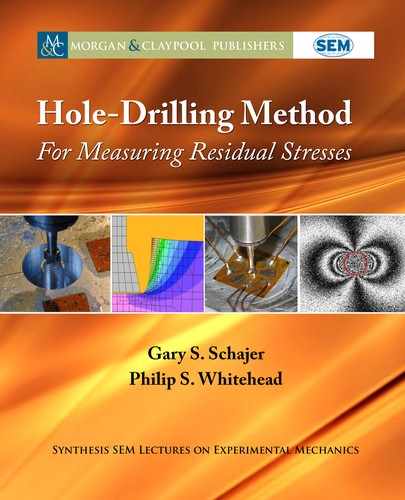1.3. SOURCES OF RESIDUAL STRESSES 11
similar in the grinding and transverse directions. e use of un-cooled abrasive discs or “abusive”
grinding may produce tensile residual stresses that extend to depths greater than 2 mm.
Material removal using low-speed abrasion, e.g., honing, can result in the creation of
small, near-surface residual stresses that penetrate just a few microns. Such stresses are difficult
to detect using relaxation methods such as hole-drilling and may require diffraction to quantify
the resultant distributions.
Maximum temperatures generated during wire or die-sinking electro-discharge machin-
ing (EDM) generally exceed those attained during most grinding processes. As a result of the
high process temperatures, molten material not ejected from the surface and removed by the flow
of dielectric fluid re-solidifies at the surface to produce a characteristic “re-cast layer.” Residual
stresses in this layer are always tensile. Because of difficulty in the precise control of adequate
flushing of dielectric fluid in die-sinking EDM, the resulting penetration depth of tensile resid-
ual stresses is often greater than for wire EDM.
1.3.5 SURFACE TREATMENTS
Because many material forming and removal process create tensile residual stresses at or close
to the surface, methods have been developed for treating surfaces so that the tensile and often
variable near-surface stresses are replaced by regular and predictable compressive stress. ese
methods include the following.
• Shot-peening is a process where small hardened balls, usually steel or iron, are blasted
onto the material surface to cause local plastic deformation and induce surface compres-
sion. Depending on the size of the shot and intensity of the blasting process, the resulting
compressive stresses can penetrate to depths in the range 100 m–1.5 mm. For thin sec-
tions or delicate components, ferrous shot can be replaced by small glass spheres.
• Laser shock-peening produces layers of compressive stress that extend to depths signif-
icantly greater than those produced by shot-peening. For this process, an intense laser
beam is directed at the target surface. e resulting rapid rate of heating at the surface
produces an intense shock wave, generating in-plane compressive residual stresses at the
surface. Compressive stresses to depths exceeding 2 mm can be achieved while exposing
the component to lower levels of surface damage and contamination than shot-peening.
• Deep rolling and roller burnishing are methods of cold working component surfaces to
generate compressive residual stresses and improve surface finish. In both cases a hardened
roller or sphere is pressed against the target surface and moved in a controlled manner. De-
pending on the material and the roller geometry, compressive stress penetration in excess
of 2 mm can be achieved. While cylindrical rollers can be readily applied to shafts and
cylinder bores, burnishing using spherical rollers can be used on irregular surfaces and
controlled in much the same way as cutter tool paths using CNC machines.
..................Content has been hidden....................
You can't read the all page of ebook, please click here login for view all page.
